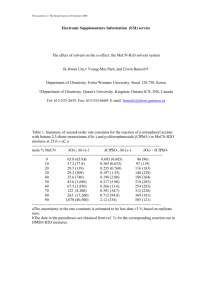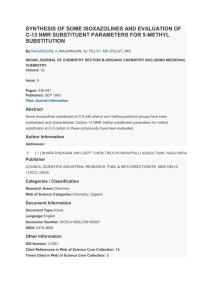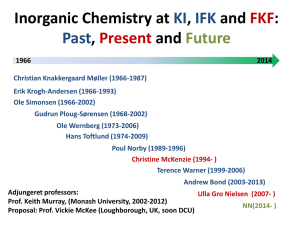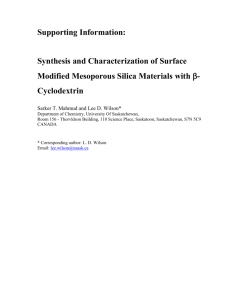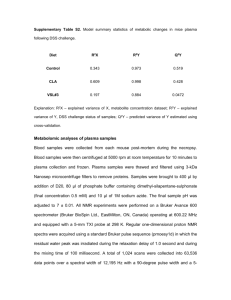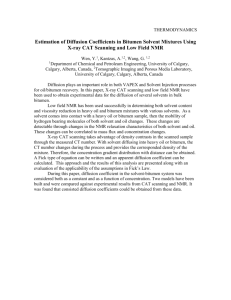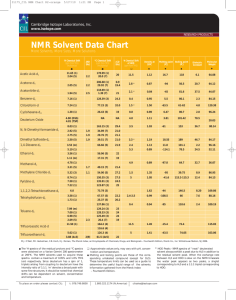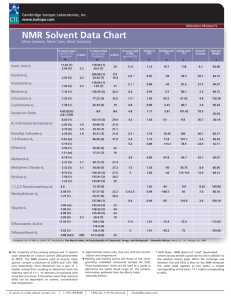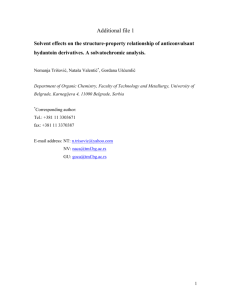1H-1,2,3-triazole has previously abtained from phenyl azine and
advertisement
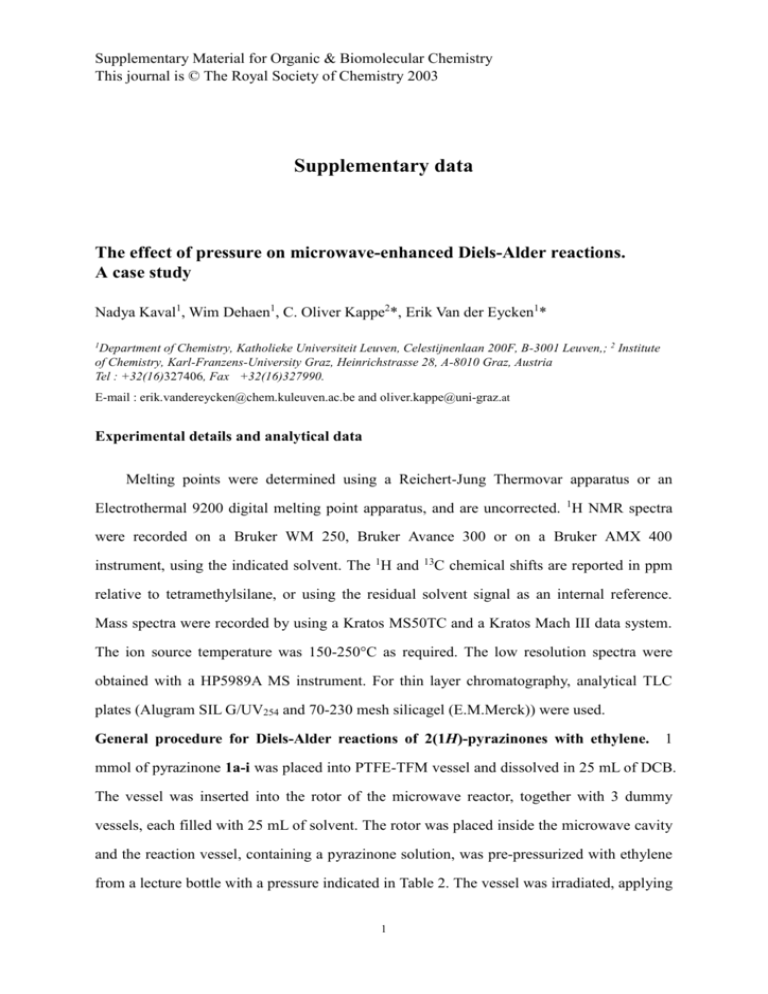
Supplementary Material for Organic & Biomolecular Chemistry This journal is © The Royal Society of Chemistry 2003 Supplementary data The effect of pressure on microwave-enhanced Diels-Alder reactions. A case study Nadya Kaval1, Wim Dehaen1, C. Oliver Kappe2*, Erik Van der Eycken1* 1 Department of Chemistry, Katholieke Universiteit Leuven, Celestijnenlaan 200F, B-3001 Leuven,; 2 Institute of Chemistry, Karl-Franzens-University Graz, Heinrichstrasse 28, A-8010 Graz, Austria Tel : +32(16)327406, Fax +32(16)327990. E-mail : erik.vandereycken@chem.kuleuven.ac.be and oliver.kappe@uni-graz.at Experimental details and analytical data Melting points were determined using a Reichert-Jung Thermovar apparatus or an Electrothermal 9200 digital melting point apparatus, and are uncorrected. 1H NMR spectra were recorded on a Bruker WM 250, Bruker Avance 300 or on a Bruker AMX 400 instrument, using the indicated solvent. The 1H and 13C chemical shifts are reported in ppm relative to tetramethylsilane, or using the residual solvent signal as an internal reference. Mass spectra were recorded by using a Kratos MS50TC and a Kratos Mach III data system. The ion source temperature was 150-250°C as required. The low resolution spectra were obtained with a HP5989A MS instrument. For thin layer chromatography, analytical TLC plates (Alugram SIL G/UV254 and 70-230 mesh silicagel (E.M.Merck)) were used. General procedure for Diels-Alder reactions of 2(1H)-pyrazinones with ethylene. 1 mmol of pyrazinone 1a-i was placed into PTFE-TFM vessel and dissolved in 25 mL of DCB. The vessel was inserted into the rotor of the microwave reactor, together with 3 dummy vessels, each filled with 25 mL of solvent. The rotor was placed inside the microwave cavity and the reaction vessel, containing a pyrazinone solution, was pre-pressurized with ethylene from a lecture bottle with a pressure indicated in Table 2. The vessel was irradiated, applying 1 Supplementary Material for Organic & Biomolecular Chemistry This journal is © The Royal Society of Chemistry 2003 a 2 min ramp to reach 190°C or 3 min ramp to reach 220-250°C, and an additional time as indicated in Table 2 (reaction temperature measured inside with a gas balloon thermometer). After cooling to 40°C (20-30 min) the solvent was removed under reduced pressure and the crude adduct 2a-h was hydrolized according to the methods described below. Method A: The crude adduct 2a-h was suspended in 25 mL of 1M NaOH/THF (1:2) and stirred at room temperature for 2 hours. Then the mixture was neutralized with 1M HCl and the THF evaporated. The residue was extracted with chloroform (3x), washed with water, dried over sodium sulfate and after filtration the solvent was evaporated. The bislactam 3a-g was purified by column chromatography over silica gel using a mixture of dichloromethane and ethyl acetate (1:2) as the eluent. For the yields see Table 2. Method B: The adduct 2a-h was suspended in 4.5 mL of 1M NaOH/dioxane (1:2) and irradiated in a single-mode microwave reactor (EmrysSynthesiser, Personal Chemistry AB) at 70°C for 5 min. The crude mixture was treated as described under (A). 2-(p-methoxy)benzyl-4-chloro-2.5-diazabicyclo[2.2.2.]octane-3.6-dione (3d). mp 189-190°C, 1H NMR (CDCl3-CD3OD 3:1): 7.13 (d, J=8 Hz, 2H), 6.81 (d, J=8 Hz, 2H), 4.69 (d, J=14.6 Hz, 1H), 4.29 (d, J=14.6 Hz, 1H), 3.87 (m, 1H), 3.74 (s, 3H), 2.35 (m, 1H), 2.20 (m, 1H), 1.76 (m, 2H), 13 C NMR (CDCl3-CD3OD 3:1): 170.3, 166.4, 159.9, 130.0, 127.8, 114.8, 76.2, 59.1, 55.6, 49.2, 36.1, 25.1, DEPT (CDCl3-CD3OD 3:1): 130.0, 114.8, 59.1, 55.6, -49.2, -36.1, -25.1, MS (CI): mz (%) = 295 (34) [M+], 121 (100) 4-(4,6-Dichloro-3-oxo-2-phenyl-2,5-diazabicyclo[2.2.2]oct-5-en-1-yl)-benzoic acid methyl ester (2h). mp 268-270°C, 1H NMR (DMSO-d6): 7.75 (d, J=8 Hz, 2H), 7.53 (d, J=8 Hz, 2H), 7.08 (m, 5H), 3.79 (s, 3H), 3.21 (m, 1H), 2.59 (m, 3H), 13C NMR (DMSO-d6): 166.4, 165.1, 163.2, 138.3, 137.8, 132.0, 130.8, 129.2, 129.0 (x2), 128.4, 89.6, 72.5, 53.1, 34.8, 30.8, DEPT (DMSO-d6): 132.0, 129.2, 129.0 (x2), 128.4, 53.1, -34.8, -30.8, MS (CI): mz (%) = 403 (100) [M+], 283 (7), 248 (5). All spectral data of adducts 3a, b, c, e, f, g are in accordance with the literature.10 2
